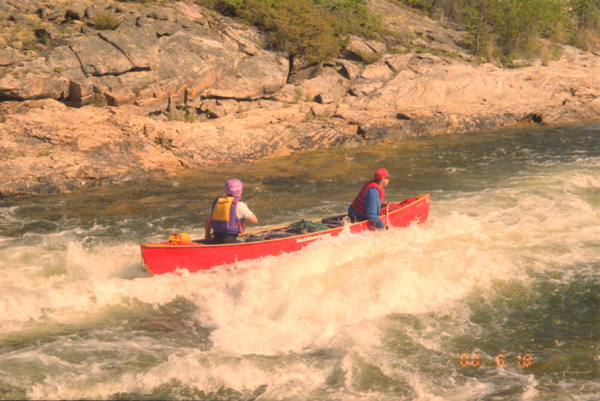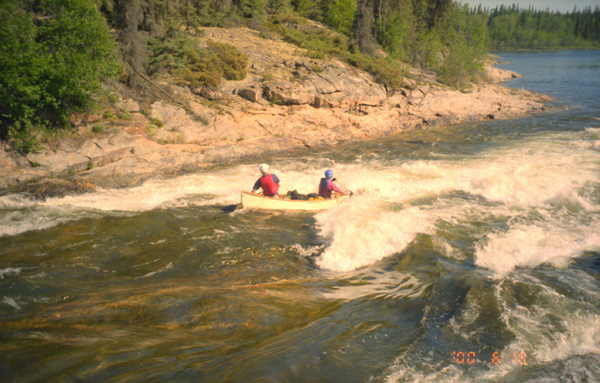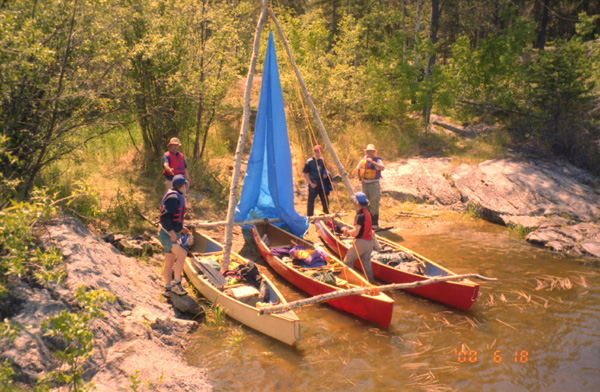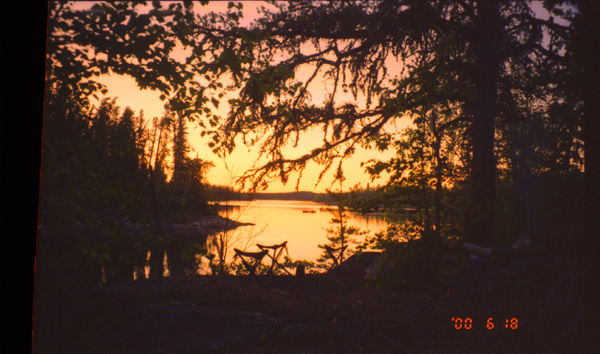
Day 4, Sunday 18
June
Normal morning routine – Peter’s coffee and dry granola. We were on the river by 9:00 am, but hung around the bottom of Trout Rapid #1 to practice eddying in and out for a while. At 9:30 we continued down Trout Rapids #2 and #3.
We ran this rapid without really looking at it.
Most of us had run this rapid way back in ’93. That time, we ran it in empty canoes. We still treasure the memory and photo of Darryl flying out of his canoe, and then swimming back to it and completing the job by submerging the back end. Rick, in the stern, looked on in disbelief as the canoe slowly sank beneath him.
This time we scouted the rapid from the campsite and then ran it, fully-loaded, one at a time, while the others watched from the shore.

Brent and Jason went down fine, with a bang on a rock.

Peter and Warren took what they thought was a better line
They actually banged a big rock in the middle of the final curling wave. The rock was in the same spot where Warren had smacked it 7 years before. The Kevlar canoe took this much better than expected (although Peter covered up some damage with a Kevlar skid plate after returning home).

Mike and Darryl came down just fine as well
Although they also bumped a couple of rocks. About 500 metres later we came to Rock Trout Portage.
A pair of outfitters aluminum boats had been fishing in Stack Lake. These passed us at the entrance to the river, and we watched them from a distance with some surprise as we saw the second guide unload his passengers and then appear to line his boat over the lip of the rapid. Must be an easy rapid we said to ourselves.
We arrived and discovered that the fishing camp had built a mini-dock at the top and a set of stairs at the bottom of the rapid!. This seemed to be catering to lazy fisherman/tourists a bit too much, but looking at the girth of the fisher people perhaps it was necessary. The guide had in reality skidded his boat down a ladder in the rapid.
We scouted the rapid and Peter and Warren then ran it with no problems. They scurried over to watch the other canoes come down. It was at this point, while watching Mike and Darryl recover after being swept away from their intended path, that Peter discovered that this was the scene of Mike and Peter’s 1996 swim! They had capsized at the top of this rapid, and Peter breathed in a lot of water while being swept under a curling wave farther down. Mike dragged Peter to shore, while Warren dove in to rescue the canoe.
Darryl and Mike scraped down the second part of the rapid, and then Brent and Jason did the same. No drama, and Brent’s appreciation for a Royalex canoe increased yet again.

Taking a breather at the bottom of Rock Trout
We ran this rapid. We had expected it to be almost non-existent, based on our experience seven years before. But, at the current water levels, the rapid was a lot more fun than expected. We ran it without scouting from the shore, just stood up in the canoes, looked and said “Looks fine”. All three canoes had good, bumpy rides down the haystacks. Some took in more water than others…
The course through Nipew Lake consists of about 7 km easterly and then a further
5 km northeasterly. The wind was by now from the south, and based on our
experience from the previous day when the wind blew strongly all through lunch
and then died during the afternoon, we postponed lunch and constructed the Mad
River Explorer trimaran II. Based on our experience from the previous day, we wanted the masts to be taller.
Unfortunately, this meant HEAVY trees (100+ lbs.), because this
particular location didn’t have any long skinny ones.
So we wrestled them into position and pushed off into the water.

The Mad River Explorer Trimaran II
Once under sail, we could eat at our leisure.

Warren slicing salami

Lunch aboard
Because the masts were so much heavier, we used an extra strong rope to support them. But, because we wanted to avoid chaffing the portage yokes, we didn’t tie the canoes together the same way. This meant that the trimaran could flex like a parallelogram which is not a good thing. As we pulled the tarp tight to catch the wind, the inevitable happened. The trimaran flexed, one canoe slid backwards, taking with it one leg of the mast. The masts then tilted forward at such an angle that the ropes could barely support them and the base tried to slip back under the thwart. The force of the wind made the situation even worse. We had to release the sail and let it flap in the wind, while Darryl and Jason held the masts up. If they had fallen, at least one of the bowmen would probably have been damaged, and even more importantly, the yokes and gunwales of the canoes would have been shattered. But we pushed the masts back up into position, and added a diagonal rope to stop the trimaran from acting like a flexible parallelogram. From then on, the sailing was good. The extra height of mast got more sail up into the wind, and sometimes we could actually see where we were going under it.
That day the wind was more constant, one gust blowing out our main sail grommet! Generally we made better speed than fast paddling, and ate a relaxed lunch en route. It was lots of fun and stress when a big gust of wind struck, and scrambling around when it looked like we weren’t going to make it in front of an island on the present tack. In these situations, the bowmen were asked to “become” dagger-boards by putting their paddles into the water. It was quite impressive how this little act could greatly affect our direction of travel. Most of the time, the hulls of the canoes did a pretty good job of limiting sideways drift, although the bows created large, asymmetrical bow waves, fully 6 inches higher on the leeward side.
Mike was trailing a line and as we rounded a corner between the Selby Peninsula and Fletcher Island he hooked a large (estimated 22 lbs.) jack. Since the wind had just started howling, we were cruising fast at the time. We hurriedly let the sail loose, but as the fish came close, it passed under the canoes and snapped the line so we were unfortunately unable to verify the size, other than to say it looked big as it passed under us.
Going through the narrow channels below Nipew Lake, the wind was fitful. We alternated sailing and paddling.
We ran the fast water below Fletcher Island still in trimaran rig, but with the sail lowered. The wind was again favourable for the reach up to Hayman Lake so we hoisted the sail again, again with partial success. We paddled to Donaldson Island, where we found our favorite campsite already occupied by about 8 canoes, so we continued on to our old fishing site. It’s a little smaller, but very pleasant and the fishing is excellent. So we beached (well, almost, actually we just got it near the rocky shore) and dismantled the trimaran.
A serious fishing expedition was soon organized, which resulted in 7 walleye and two jack. All of the fishermen caught at least one fish, and lost several. Mike took on the major job of filleting, while Brent prepared Shepherds’ Pie for dinner. After all-you-can-eat fish, the party groaned to do justice to the pie.
The last of the rye of about one ounce each was consumed.

Hayman Lake from the camp